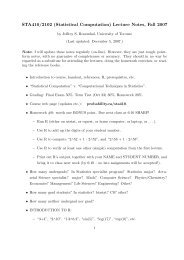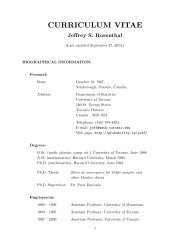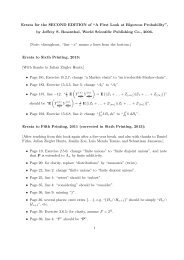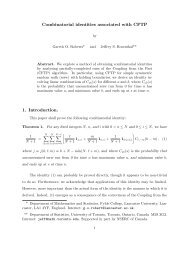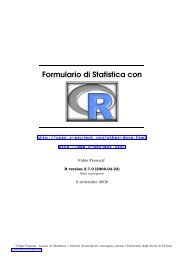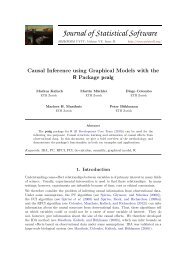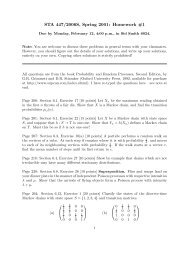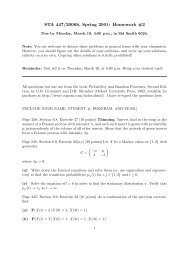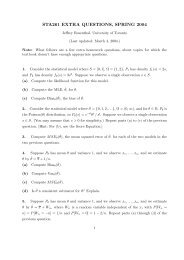final report - probability.ca
final report - probability.ca
final report - probability.ca
You also want an ePaper? Increase the reach of your titles
YUMPU automatically turns print PDFs into web optimized ePapers that Google loves.
when the lo<strong>ca</strong>l correlations are sufficiently small so that no phase transitions occur. The Gibbs measure used as<br />
the target distribution for this model is such that the field’s correlations decrease exponentially fast as a function<br />
of distance. In particular, they consider a Gibbs measure on R Zr which has a density with respect to ∏ k∈Z µ (dx k)<br />
r<br />
given by<br />
{<br />
}<br />
exp<br />
− ∑ k∈Z r U k (x)<br />
where U k is a finite-range potential, depending only on a finite number of neighboring terms of k. Markov random<br />
fields with signifi<strong>ca</strong>nt phase-transition behavior will require algorithms that use proposals with large jumps in order<br />
to provide sufficient mixing. This will often yield degenerate algorithms, as the acceptance rate will converge to 0,<br />
making the algorithm practi<strong>ca</strong>lly useless.<br />
2.2 Roberts and Rosenthal (2001): & Inhomogeneous Targets<br />
Another validation of the asymptotic optimal acceptance rate equaling 0.234 for the RWM was proven by Roberts<br />
and Rosenthal (2001) [RR01] in the <strong>ca</strong>se of inhomogeneous target distributions. Specifi<strong>ca</strong>lly, they considered<br />
inhomogeneous target distributions of the form<br />
d∏<br />
π (x) = C i f (C i x i ) , (2.1)<br />
i=1<br />
where the {C i } are themselves i.i.d. for some fixed distribution, and f is again a fixed one-dimensional density<br />
satisfying the regularity conditions discussed in (1.10). The components in this target are uncorrelated, but heterogeneously<br />
s<strong>ca</strong>led. The target (1.8) used in [RGG97] corresponds to the <strong>ca</strong>se where the {C i } are all constant in (2.1).<br />
In order to obtain general results for the limiting theory of the RWM algorithm applied to (2.1), it is assumed that<br />
C i have mean 1 and variance b < ∞.<br />
Theorem 2.1. (Theorem 5 in [RR01]) Consider RWM with target density (2.1), and with proposal distribution<br />
N ( (<br />
0, I d l 2 /d )) , for some l > 0. Consider the time-res<strong>ca</strong>led process consisting of the first component of the induced<br />
Markov chain, i.e., W (d)<br />
t = C 1 X (1)<br />
[td] . As d → ∞, W t<br />
d ⇒ W t , where W t satisfies the Langevin SDE<br />
dW t = 1 2 g′ (W t ) (C 1 s) 2 dt + (C 1 s) dB t ,<br />
with B t being a standard Brownian motion and where<br />
(<br />
)<br />
s 2 = 2l 2 Φ −lb 1/2 I 1/2 /2<br />
= 1 b · 2 ( l 2 b ) (<br />
Φ − ( l 2 b ) )<br />
1/2<br />
I 1/2 /2 ,<br />
with I = E f<br />
[(g ′ (X)) 2] .<br />
Remark 2.2. When considering a functional of the first coordinate of the algorithm, the efficiency of the algorithm<br />
as a function of acceptance rate is the same as that found in [RGG97], but multiplied with a global “inhomogeneous”<br />
factor C1/b. 2 For a fixed function of f, the optimal asymptotic efficiency is proportional to C1/bd. 2 In particular,<br />
the efficiency of the algorithm is now slowed down by a factor of b = E ( )<br />
Ci<br />
2 /E (Ci ) 2 , which by Jensen’s inequality<br />
is greater than or equal to 1, with equality coming only when the factors C i are all constant, which is equivalent to<br />
the form of (1.8).<br />
Remark 2.3. When the values of C i are known, then instead of using the proposal distribution N ( )<br />
0, σ 2 (d) I d ,<br />
one should use an inhomogeneous proposal which is s<strong>ca</strong>led in proportion to C i for each component, i..e, we should<br />
consider proposals of the form N ( 0, ¯σ 2 (d) diag (C 1 , . . . , C d ) ) . This would then yield a RWM applied to the form<br />
of the target (1.8), since the s<strong>ca</strong>ling in the proposal and in the target would <strong>ca</strong>ncel each other out. This would<br />
alleviate the inefficiency factor of b as discussed above. See Theorem 6 and the subsequent discussion in [RR01] for<br />
a more detailed assessment of inhomogeneous proposals for such target distributions.<br />
The results above provide some theoreti<strong>ca</strong>l justifi<strong>ca</strong>tion for a frequently used strategy as suggested by Tierney<br />
in [Tie94], which is to use a proposal distribution that is a s<strong>ca</strong>lar multiple of the correlation matrix obtained<br />
by estimating the correlation structure of the target distribution, perhaps through an empiri<strong>ca</strong>l estimate based<br />
on a sample MCMC run, or numeri<strong>ca</strong>lly through curvature <strong>ca</strong>lculations on the target distribution itself. Using<br />
inhomogeneous proposals by first obtaining a preliminary estimate of the C i <strong>ca</strong>n thus lead to more efficient Metropolis<br />
algorithms.<br />
,<br />
16



